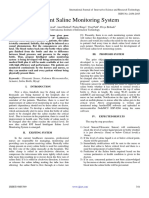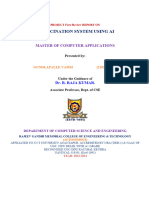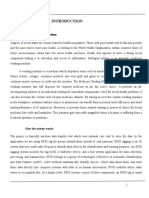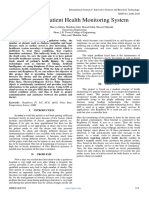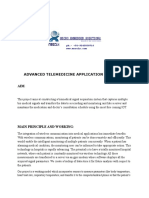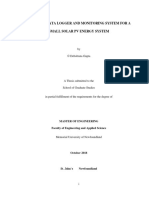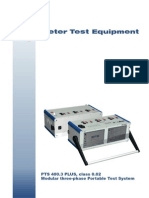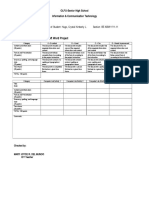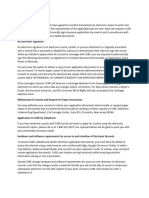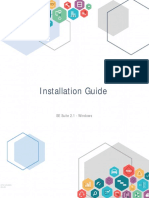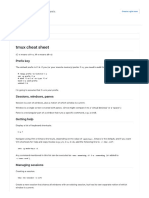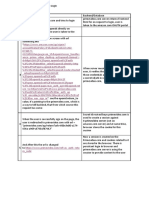Remote Patient Monitoring System
Remote Patient Monitoring System
Uploaded by
ijdpsCopyright:
Available Formats
Remote Patient Monitoring System
Remote Patient Monitoring System
Uploaded by
ijdpsOriginal Description:
Copyright
Available Formats
Share this document
Did you find this document useful?
Is this content inappropriate?
Copyright:
Available Formats
Remote Patient Monitoring System
Remote Patient Monitoring System
Uploaded by
ijdpsCopyright:
Available Formats
International Journal of Distributed and Parallel Systems (IJDPS) Vol.3, No.
5, September 2012
REMOTE PATIENT MONITORING SYSTEM
Sherin Sebastian, Neethu Rachel Jacob, Yedu Manmadhan, Anand V. R. , M. J. Jayashree
Department of Electronics and Communication Engineering Mar Baselios College of Engineering & Technology Nalanchira, Trivandrum, India- 695015
ssebast3@gmail.com nee2rachel@gmail.com yedujammy@yahoo.com anandvr123@gmail.com jayashreemj@yahoo.com
ABSTRACT
The Telemedicine system comprises of both hardware and software components at both the patient and doctor ends. A leading field for application of telemedicine is in the field of cardiology where ECG is the major tool for diagnosis. The proposed project in this paper provides an image based techniques to acquire and analyse a constant streaming of ECG signal through digital camera for image capturing, information extraction and analysis performed using MATLAB tools as well as data sending system based on internet network. The method captures the vital signs and parameters from the ICU monitoring machine using a webcam and transmits the image through the internet. This original image is then availed to the consulting doctor via an ANDROID cell phone. In case of anomaly a notification is send to the doctors phone. The paper proposes a method to capture, compare and generate alert regarding the patients condition using the heart rate and make the captured image be available to the physician.
KEYWORDS
Telemedicine, ECG, MATLAB, C2DM, Android
1. INTRODUCTION
Tele-health and telemedicine are now becoming more engrained in the delivery of everyday health care, distance education and also health care administration. Lots of patients in underserved areas are receiving services that may not have otherwise received without travelling great distance or overcoming other transportation barriers. The services provided through telemedicine range from primary health care to the highly specialised care found in leading academic medical centre. Services are provided across the spectrum, from the youngest of patients to the fragile elderly. Tele-health systems have many applications in hospitals, clinics, nursing homes, rehabilitation hospitals, homes assisted living facilities, schools, prisons or health departments. Tele-healthcare may be defined as the use of information technology to provide healthcare services at a distance. It includes anything like medical services at the inpatient or at the outpatient stage. What the doctors actually would like to see is constant monitoring of the vital parameters so they always know what the history is and how big the change from yesterday to
DOI : 10.5121/ijdps.2012.3509 99
International Journal of Distributed and Parallel Systems (IJDPS) Vol.3, No.5, September 2012
today be and when you have these findings and have these data points available, then a much earlier intervention can happen for a patient. Telemedicine can be extremely advantageous for people living in isolated communities and remote regions. It is currently being applied in almost all medical domains. Patients who live in such areas can be seen by a doctor or specialist, who can provide a precise and complete examination, so that the patient need not travel the normal distances like those from conventional hospitals. New developments in mobile collaboration technology with the use of hand-held mobile devices allow healthcare professionals the ability to view, discuss and assess patient issues. Telemedicine is being used as a teaching tool, by which experienced medical staff can observe, show and instruct medical staff in another location using more resourceful and faster examination techniques. It improved access to healthcare for patients in remote locations. Telemedicine reduces the cost of healthcare and as well as increase the efficiency through better supervision of diseases, shared health professional staffing, and reduced travel times. The Telemedicine system comprises of hardware and software at both the patient and consultant doctor ends, with some of the Diagnostic Equipments and pathology microscope or camera provided at the patient end. Through a Telemedicine system consisting of simple computer with necessary communication systems, the medical images as well as other information of the patients can be sent to the consultant doctors, through the satellite link in the form of digital data packets. For the purpose of reception of these data packets the usage of hand held devices such as the cell phone has been recognized since the day it has become commercially available at every housel hold. These packets are received at the doctors end and the data is reconstructed so that the consultant doctor can study the information, do the diagnosis, interact with the patient and put forward the appropriate treatment. Telemedicine facility together with technological advances in communication facilitates the specialist doctor and the patient, separated by thousands of kilometres to see and talk to each other. In the recent past, it has been shown that using a bio signal acquisition unit connected to a computer, vital signals can be transmitted from the hospital to any destination in a store-andforward mode or in real-time mode. Moreover, newer cellular access technologies, such as Third generation (3G), and others provide much higher data transmission speeds (rates) thus ensuring constant and high speed internet access smart phones and mobile modems than basic second generation (2G). This relatively new technology in wireless communication is utilized for our proposed method. Cardiology is one of the areas in which telemedicine is showing major growth. Lifethreatening cardiovascular diseases, such as heart attacks, arrhythmias and strokes, are the important cause of death in the world. Prevention of cardiovascular diseases (CVD) requires early detection and diagnosis. Arrhythmia is a general term used to denote disturbances in the heart's rhythm [I]. Arrhythmias can be recognized by evaluating the ECG in a systematic manner. Electrocardiogram (ECG) is one of the most frequently used diagnostic tools for heart diseases these days. The accurate interpretation of ECG is basically required in order to evaluate the important information inside the ECG signal. The electrocardiogram (ECG) is the graphical representation of the electrical activity of the heart. It is obtained by connecting electrodes to the body surface. It has been used as a diagnostic tool for over a century and is extremely useful in identifying cardiac disorders. The conventional visual analysis, of the ECG signals is absolutely not much effective and is also time consuming. Instead the use of heart rate variations as an indicator of cardiac arrhythmia can act an easier and more effective method for the detection of heart conditions.
100
International Journal of Distributed and Parallel Systems (IJDPS) Vol.3, No.5, September 2012
In Normal Sinus Rhythm the heart rate lie between 60 to 100 beats per minute for a human being as shown in the Fig. 1. This rate might vary from one person to the other. It tends to be faster in children and slower in older people but the cardiac rhythm will be regular. In the case of abnormalities such as Bradycardia the heart rate is less than 60 beats per minute and for Tachycardia the heart rate will be greater than 100 beats per minute. In both cases the cardiac rhythm is regular as indicated by Fig. 2 and Fig. 3.
Figure 1: Normal Sinus Rhythm
Figure 2: Bradycardia
Figure 3: Tachycardia Thus variations in heart rates can lead to various cardiac arrhythmias. This paper aims at proposing a method for providing the consulting doctor with the latest information regarding the patients vitals and generate an alert signal based on the variations in the patients heart rate. This alert is then send, along with the current patient vitals to the consulting doctors cell phone, thereby facilitating quick decissions and immediate intervention for the doctor if the patients condition get worse. The next section describes the background that led to this particular project. The third section includes the details about the proposed project. Fourth section describes the methods used to chive the final result. Fifth and Sixth section explains the result and conclusion respectively.
2. BACKGROUND
The earlier system that existed introduced an ECG measurement, analysis and transmission system with a mobile phone as a base station [2]. The system was based on a small-sized mobile ECG recording device which sends measurement data wirelessly to the mobile phone [3]. In the mobile phone, the received data is analyzed and in cases of any abnormalities found among parts of the measurement data; it will be send to a server for the use of medical personnel simultaneously. However, because of the limits of electronics support and processing units within the mobile phone, the overall performance was hardly operated in an ideal condition [4]. Delay in the data transmission might also disrupt the data analysis and measurement.
101
International Journal of Distributed and Parallel Systems (IJDPS) Vol.3, No.5, September 2012
Figure 4: Previous methods Another more recent method suggests direct measurement of ECG [5] or blood pressure [6] for the detection of arrhythmias. But these systems depend completely upon the proper operation of their sensors. So they cannot be used along with the existing cardiac sensors of the bedside monitors in ICU, also a variation in the placement of the sensors of blood flow might lead to false alarms or a critical condition being over looked. Most of these systems uses a GSM module to generate an SMS to the doctor but does not convey the actual readings of the patient during the critical condition [7].
3. PROPOSED PROJECT
To avoid the limitations of the earlier system, the proposed project in this paper implements the images based techniques and digitization ECG signal through digital camera for image capturing, information extraction and analysis using MATLAB tools as well as data sending system based on internet network. That is, a predefined amount of measurement data around this event is sent through the internet network. The main aim of this project was to develop a system which captures the vital signs and parameters from the ICU monitoring machine using a webcam and make this data be available to the personal doctor who might not be present in the hospital or even in the country. The webcam will capture images from the screen of the bedside monitor at a rate of about one image every four seconds. These captured images streamed into MATLAB where it is processed and will be constantly uploaded to the application server. ANDROID application is used to get these data on the mobile phone from the users server. In case of any abnormality, the doctor is alerted by sending a notification from C2DM server to his mobile.
102
International Journal of Distributed and Parallel Systems (IJDPS) Vol.3, No.5, September 2012
Fig. 6: Block Diagram The algorithm starts with the capturing of images by using a real time operating digi digital webcam and saving them in the computer. The format of captured image above can be either jpg or jpeg. Then the algorithm consists of a series of image processing techniques that perform image conversion, image cropping and image comparison. The processed image will be processed analyzed for any anomaly in the heart rate of the patient. In case an anomaly is detected a text document is generated. The processed image along with this text document, generated in case of anomaly, is uploaded to the server using web application. The ANDROID phones are application. registered in the C2DM server and have unique IDs. The images uploaded to the server can be viewed from the server itself by using the ANDROID application. The notification is send in case of anomaly to the doctors phone.
Fig. 5: Block Schematic Representation
103
International Journal of Distributed and Parallel Systems (IJDPS) Vol.3, No.5, September 2012
4. METHODOLOGY
4.1. Image Acquisition and Processing
A low cost webcam is used to acquire the images from the monitor of the bedside ICU monitoring machine. MATLAB is used for further processing of the captured images. Initially, a connection is established between the webcam and MATLAB. Once the connection is established an object is initiated which is in charge of capturing the required image frames using the webcam. This object runs commands to capture an image of the screen of the bedside monitor of the cardiac ICU using the webcam, at the rate of one image every four seconds. This is achieved by running the program in an infinite loop inside the MATLAB. The images thus obtained are then used for image processing.
Fig 7: Screen of the ICU Monitor The image captured will contain information regarding the patients heart rate and other information such as ECG, blood oxygen content, breathing rate etc. From the image the part containing the heart rate is cropped out for analysis. The image is cropped such that each cropped image will contain a single digit of the numerical value representing the heart rate.
Fig. 8: Digits representing the heart rate which was cropped from the image These cropped images are then converted from RGB to black and white for comparison. This conversion enables the images to be compared with sample images easily. These black and white, cropped images are then compared with the already saved black and white sample images sample images inside the computer.
104
International Journal of Distributed and Parallel Systems (IJDPS) Vol.3, No.5, September 2012
Fig. 9: Digits converted from RGB to black and white The comparison is achieved by performing the subtraction function in MATLAB. For this the sample images are subtracted from the cropped image and the resultant image is checked to determine if no resultant grey or white pixel values remained above the threshold value. If an almost perfect match is achieved then the numerical value of the cropped image is fixed as the value of the sample image. This comparison helps obtain the numerical value of the heart rate of the patient from the images.
= =
Fig. 10: The resultant of an imperfect comparison (so the digit is not 6)
Fig. 11: The resultant of a perfect comparison (so the digit is 7) This value is then checked to know whether the heart rate of that patient lies within the range of normal values (which is usually within 60 beats per minute to 100 beats per minute for normal humans, but this may vary from one patient to the other). Irrespective of the analysis outcome, the image captured is stored into a destination folder. If the heart rate is falling within the normal range then the destination folder will contain only the captured original image which has been saved there. This image is then uploaded to the application server, specified by the URL using MATLAB commands. This image can then be available to the doctors through his / her mobile phone. Data uploading is performed using a batch files. The batch file runs command not only to upload the images to the server from the destination folder but also to remove the image from the folder once it is uploaded. So once uploaded to the server all data stored in the destination folder is removed from the there and the folder is left empty for the next data. In case the heart rate falls outside the normal range for the patient, then a text document is generated along with the image and saved into the destination folder along with the captured image. The batch file will upload this text file along with the image, into the server. When the server detects this text file it will send an alert to the C2DM server along with the ID of the phones registered into the service. The C2DM will then send a notification to all the registered phones alerting the doctor regarding the patients condition. Since a batch file is used to upload the content of the destination folder, the image will be uploaded to the server at all time irrespective of whether an anomaly was detected or not. So the doctor can always access the patients data through his android device.
105
International Journal of Distributed and Parallel Systems (IJDPS) Vol.3, No.5, September 2012
Fig. 12: Block Diagram of Image Processing
4.2. Server
The mobile phone stores the recorded data in a SQLite database [8]. This is needed because it is not necessary that there will always be a network available to forward the biomedical data to the server. For the database on the server side, MySQL was chosen over SQLite as database management system. The reason for this was that MySQL offers the possibility to dene foreign keys whereas SQLite does not. Further consistency conditions can also be dened on the database layer. Server side should also provide a way to present the collected data to the healthcare specialists. [9] Server supports different services in real-time to the users. It continuously receives the processed data from the computer and stores it in a database. It sets up Web Application Server for different users such as physicians and medical centre to have real-time and continuous access to patients vital signs through internet [10]. The image obtained is stored into a folder in a specified memory location. In case of emergency the MATLAB will generate a .txt file which will also be stored into the same folder. The MATLAB will then call the batch file. This batch file contains the code that will upload the content of the destination folder into the server. The image uploaded is stored in the server.
106
International Journal of Distributed and Parallel Systems (IJDPS) Vol.3, No.5, September 2012
Fig. 13: Data Uploading Block Diagram
4.3. Android Application
Android is an open-source software stack for the mobile devices provided by Google and the source Open Handset Alliance [8]. All the ANDROID applications are written using the Java . programming language. For the development of applications, a Software Development Kit Development (SDK) is provided with the necessary tools and APIs. An activity will request some data from the server to display these to the user or send data provided by the user, to the server. A service, like the network service, will primarily send data to the server. To accomplish this, the components can use the network adapter. It allows the user to register an account on the web application from the mobile phone and also allows the doctor to see the image on the mobile phone. Android market must be installed in the system and the user should be logged into the android market through his Google account. The account ID and password must be used to register into the C2DM server. When registered, each device is provided with a unique ID. This ID is given to the server for communication between the server and C2DM server. iven
Fig 14: Android phone front end
107
International Journal of Distributed and Parallel Systems (IJDPS) Vol.3, No.5, September 2012
The corresponding doctor who wants to see the image should initially register. The registered mobile will get a unique ID from the C2DM server. The data is uploaded to the application server. In case of any abnormality a text document is uploaded along with data and a notification is send to the phone from the C2DM server. The application that is installed in the android phone is called the RPMS. When the image is uploaded to the server this application makes it available to the doctor so that he can see the image in his cell phone. The server stores the images uploaded into its data base for future use. Doctor can view the images from the server. The images will be saved according to the date and time and there will be separate folders for each patient. In case the doctor doesnt want to view the images he can unregister unregister.
Fig 15: RPMS application
5. Results
Remote patient monitoring system enables the doctor who is not in the hospital to know about the details of his patient. The image of the monitor of the ICU device is processed and the image is uploaded to a server and it is made available to the doctor. Notification is send in case of abnormality. Here in this project we have done, the notification will be sent to all the doctors who have registered in the C2DM server. Also the detail of the patient is not available to the doctor. Only the name and patient ID are made available along with the image. So the future scope of this image. project is that the notification will be send only to the doctor whom the patient consults. That is, the alert send can be made specific. Along with the name and ID, more patient details can be sent.
108
International Journal of Distributed and Parallel Systems (IJDPS) Vol.3, No.5, September 2012
Fig 16: The frame obtained from the video obta
Fig 17: The frame available to the doctor
6. Conclusion and Future Scope nd
The project Remote Patient Monitoring System is a telemedicine application which allows e the doctor to view the patients vital signs and parameters remotely and dynamically in real time. We propose a mobile phone based intelligent patient monitoring system with good extensibility. The image can be acquired, analyzed, transmitted and analyzed remotely in a quasi real time sense. The system allows the doctors advice to be given to the patients even if advice he is not present near the patient. As a summary, the presented monitoring system will be a cost effective, flexible and robust solution supporting a unique mobile based computational platform. Here in this project we have done, the notification will be send to all the doctors who have registered in the C2DM server. Also the details of the patient are not available to the doctor. Only the name and patient ID are made available along with the image. The future image. scope for this project is that the notification will be send only to the doctor whom the patient consults. That is, the alert send can be made specific. Also more patient details can be sent along with the patient name and ID.
109
International Journal of Distributed and Parallel Systems (IJDPS) Vol.3, No.5, September 2012
ACKNOWLEDGEMENT
The authors would like to acknowledge the contributions of Royal SUT for giving us the permission to use data from their cardiac ICU and providing us with all the necessary facilities. We would also like to thank Dr. A.C. Rao, Consultant Cardiologist at SUT Royal Hospital and Mr. Richie Daniel Johnson for all their necessary support and guidance. We acknowledge our gratitude to the members of faculty in the Dept. of ECE and all our friends for their cooperation and encouragement to complete this work.
REFERENCES
[1] 'International Cardiovascular Disease Statistics, Statistical Fact Sheet-2007 Update', American Heart Association, Dallas, Texas, 2007. [2]Lai Khin Wee, Yeo Kee Jiar, Eko Supriyanto Electrocardiogram Data Capturing System and Computerized Digitization using Image Processing Techniques International Journal of Biology and Biomedical Engineering Issue 3, Volume 3, 2009 [3] Khor S, Nieberl J, Fgedi K, Kail E Internet based, GPRS, longterm ECG monitoring and nonlinear heart-rate analysis for cardiovascular telemedicine management Computers in Cardiology 2003;28:209-212. [4] Ljupco Hadzievski, Bosko Bojovic, Vladan Vukcevic, Petar Belicev, Sinisa Pavlovic, Zorana Vasiljevic-Pokrajcic, and Miodrag OstojicA Novel Mobile Transtelephonic System With Synthesized 12-Lead ECG IEEE Transaction on Information Technology in Biomedicine, Volume 8, 2004 [5] Dr.R.Sukanesh, S.Palanivel rajan, S.Vijayprasath, S.Janardhana prabhu and P.Subathra gsm based ecg tele-alert system, Department of Electronics and Communication Engineering, Dept. of Electron. & Commun. Eng., Thiagarajar Coll. of Eng., Madurai, India Innovative Computing Technologies (ICICT), International Conference 2010 [6]Sukanesh R., Gautham P. ; Arunmozhivarman P.T. ; Rajan S.P. ; Vijayprasath S. Cellular phone based biomedical system for health care Dept. of Electron. & Commun. Eng., Thiagarajar coll. of Eng., Madurai, India Communication Control and Computing Technologies (ICCCCT), IEEE International Conference 2010 [7] 1V.Ramya, 2B.Palaniappan,3Anuradha Kumari Embedded Patient Monitoring System International Journal of Embedded Systems and Applications (IJESA) Vol.1, No.2, December 2011 [8] Prof. Dr. Burkhard Stiller Mobile Healthcare on Android Devices Communication Systems Group, Diploma Thesis, Dept. of Informatics, November 2010 [9] Alma Secerbegovic, Aljo Mujcic, Nermin Suljanovic, Midhat Nurkic, Jurij Tasic The research mHealth platform for ECG monitoring, ConTel Conference, 2011 [10] Elham Dolatabadi, Serguei Primak Ubiquitous WBAN-based Electrocardiogram Monitoring System EHealth Networking Applications Conference, 2011
110
You might also like
- BOIR System To System APIUserGuideDocument22 pagesBOIR System To System APIUserGuidehector.llanosNo ratings yet
- Iot Based Health Monitoring SystemDocument12 pagesIot Based Health Monitoring SystemSamuel100% (1)
- Embedded Based Real-Time Patient Monitoring SystemDocument5 pagesEmbedded Based Real-Time Patient Monitoring SystemTabithaDsouza50% (2)
- Health Monitoring and Tracking System For Soldiers Using Internet of Things (IoT)Document6 pagesHealth Monitoring and Tracking System For Soldiers Using Internet of Things (IoT)Raghu BNo ratings yet
- Patient Monitoring System Using GSM For Hospitals and Old Age HomesDocument5 pagesPatient Monitoring System Using GSM For Hospitals and Old Age Homesvgmanjunatha100% (1)
- Abstract For Health Monitoring SystemDocument2 pagesAbstract For Health Monitoring Systemsree2728No ratings yet
- Wireless Patient Monitoring System FinalDocument9 pagesWireless Patient Monitoring System FinalkalaiyarasiNo ratings yet
- IOT BASED HEALTH MONITORING SYSTEM - DakshDocument17 pagesIOT BASED HEALTH MONITORING SYSTEM - DakshMohit MehraNo ratings yet
- Wireless Health Monitoring System Using BluetoothDocument13 pagesWireless Health Monitoring System Using Bluetoothshoeb mazzinni100% (2)
- IOT Based Health Monitoring SystemDocument43 pagesIOT Based Health Monitoring SystemYuvraj SinghNo ratings yet
- IoT Based Weather Monitoring SystemDocument6 pagesIoT Based Weather Monitoring SystemInternational Journal of Innovative Science and Research TechnologyNo ratings yet
- Role of Data Science in Covid-19Document13 pagesRole of Data Science in Covid-19Afia Irfan100% (1)
- Agricultural Based Monitoring System With Android App Sms AlertDocument53 pagesAgricultural Based Monitoring System With Android App Sms AlertvinayakaNo ratings yet
- Project PPT UpdatedDocument26 pagesProject PPT UpdatedVuyyuri GaneshNo ratings yet
- Soldier Tracking and Health Monitoring SystemDocument18 pagesSoldier Tracking and Health Monitoring SystemKavana K GowdaNo ratings yet
- Heart Disease Prediction SystemDocument3 pagesHeart Disease Prediction SystemInternational Journal of Innovative Science and Research TechnologyNo ratings yet
- Brain FingerPrintingDocument9 pagesBrain FingerPrintingLakshmi MadavanNo ratings yet
- Smart Real Time Health Monitoring System Using ArduinoDocument5 pagesSmart Real Time Health Monitoring System Using ArduinoSDS PRIORNo ratings yet
- Intelligent Saline Monitoring SystemDocument3 pagesIntelligent Saline Monitoring SystemAnonymous izrFWiQNo ratings yet
- E Vaccination System Using AiDocument17 pagesE Vaccination System Using AiBRO.V͙A͙M͙S͙I͙ Ƥeͥ†eͣrͫ꧂No ratings yet
- Finger Print Based Electronic Voting MachineDocument4 pagesFinger Print Based Electronic Voting Machinesagarsm2No ratings yet
- Iot Based Health Monitoring SystemDocument13 pagesIot Based Health Monitoring SystemSamuelNo ratings yet
- Any Time Medicine ReportDocument34 pagesAny Time Medicine Reportsupreetha100% (1)
- Advanced Voting Machine Using Face RecognitionDocument25 pagesAdvanced Voting Machine Using Face Recognitionritu OfficialNo ratings yet
- SRSA. Ppt-1Document15 pagesSRSA. Ppt-1Santhoshi RupaNo ratings yet
- FINGERPRINT Based ATM Security SystemDocument67 pagesFINGERPRINT Based ATM Security SystemRyan Hale69% (13)
- Research of Vehicle Tracking (VTracking App)Document7 pagesResearch of Vehicle Tracking (VTracking App)sailesh wankarNo ratings yet
- Title:-Iot Based Health Monitoring System Using Raspberry PiDocument28 pagesTitle:-Iot Based Health Monitoring System Using Raspberry PiGagan DeepNo ratings yet
- Wireless Patient Monitoring System To Measure Heartbeat, Body Temperature and RespirationDocument26 pagesWireless Patient Monitoring System To Measure Heartbeat, Body Temperature and RespirationSuresh Nk67% (6)
- CropDocument53 pagesCropBalasatyaappaji99 KurellaNo ratings yet
- IoT Based Patient Health Monitoring SystemDocument3 pagesIoT Based Patient Health Monitoring SystemInternational Journal of Innovative Science and Research Technology100% (1)
- Wireless Patient Monitoring System To Measure Heartbeat Body Temperature and RespirationDocument15 pagesWireless Patient Monitoring System To Measure Heartbeat Body Temperature and RespirationRanjith GowdaNo ratings yet
- Telemedicine Using IotDocument6 pagesTelemedicine Using IotjagannnnNo ratings yet
- Transformer Health Monitoring SystemDocument10 pagesTransformer Health Monitoring SystemPavan Kumar A GNo ratings yet
- Disease Drug Prediction Using MLDocument72 pagesDisease Drug Prediction Using MLsumathi100% (1)
- Advance Electronic Voting Machine Using RFID and Individual Secret PasswordDocument4 pagesAdvance Electronic Voting Machine Using RFID and Individual Secret PassworddileeppatraNo ratings yet
- Ece Seminar TopicsDocument17 pagesEce Seminar TopicsKrishna Chaitanya GorleNo ratings yet
- Lung Cancer Detection Using Digital Image Processing On CT Scan ImagesDocument7 pagesLung Cancer Detection Using Digital Image Processing On CT Scan ImagesShaka TechnologiesNo ratings yet
- Project Report FinalDocument60 pagesProject Report Finalaisha singhNo ratings yet
- Final Year Project List ECE, ICE, CSE, IT, EEE, Mech (Jntu Final Year Projects)Document9 pagesFinal Year Project List ECE, ICE, CSE, IT, EEE, Mech (Jntu Final Year Projects)nirvanaofworldNo ratings yet
- ECE 422B: Iot Based Healthcare SystemDocument20 pagesECE 422B: Iot Based Healthcare SystemThharuwn KagitaNo ratings yet
- Home Automation System Using Embedded SystemDocument8 pagesHome Automation System Using Embedded SystemHaardik GuptaNo ratings yet
- Project Title:: Fingerprint Voting System For UniversityDocument8 pagesProject Title:: Fingerprint Voting System For UniversityMunshiNo ratings yet
- IoT Based Anti Theft Floor Mat SystemDocument74 pagesIoT Based Anti Theft Floor Mat Systemrohit2001neelamNo ratings yet
- Diamond The Ultimate SemiconductorDocument53 pagesDiamond The Ultimate SemiconductorSHREYA GUDDUNo ratings yet
- Automatic Speed Control SystemDocument11 pagesAutomatic Speed Control SystemSatish ToramNo ratings yet
- Fingerprint Based Voting MachineDocument62 pagesFingerprint Based Voting MachineNaveen Kumar83% (6)
- Telemedicine Through The Internet and IntranetDocument14 pagesTelemedicine Through The Internet and Intranetalexhuq2010100% (1)
- Final Presentation On Object DetectionDocument10 pagesFinal Presentation On Object DetectionAman JindalNo ratings yet
- Drowsiness Detection System Using Machine LearningDocument4 pagesDrowsiness Detection System Using Machine LearningNIET Journal of Engineering & Technology(NIETJET)No ratings yet
- Thesis3 Low Cost Monitoring System For Solar SystemDocument125 pagesThesis3 Low Cost Monitoring System For Solar SystemEngr. AbdullahNo ratings yet
- VEHICLE THEFT ALERT ENGINE LOCK SYSTEM USING ARM7 Ijariie5380Document7 pagesVEHICLE THEFT ALERT ENGINE LOCK SYSTEM USING ARM7 Ijariie5380adhi rizalNo ratings yet
- Bme 115 Project TitlesDocument5 pagesBme 115 Project Titlesvinoth1128No ratings yet
- IOT Based Patient Monitoring System: Bachelor of EngineeringDocument21 pagesIOT Based Patient Monitoring System: Bachelor of EngineeringImran KhanNo ratings yet
- Iot Based Air Pollution Monitoring and Controlling SystemDocument16 pagesIot Based Air Pollution Monitoring and Controlling SystemVenkatNo ratings yet
- Literature Survey (1) Smart Atm Security System Using FPR, GSM, GpsDocument2 pagesLiterature Survey (1) Smart Atm Security System Using FPR, GSM, GpsRAMADEVI KESANANo ratings yet
- The Today and Future of WSN, AI, and IoT: A Compass and Torchbearer for the TechnocratsFrom EverandThe Today and Future of WSN, AI, and IoT: A Compass and Torchbearer for the TechnocratsNo ratings yet
- Real Time Health Monitoring Using GPRS Technology: Shubhangi M. Verulkar, Maruti LimkarDocument8 pagesReal Time Health Monitoring Using GPRS Technology: Shubhangi M. Verulkar, Maruti LimkarMuh Fauzi NatsirNo ratings yet
- Wireless Health Care MonitoringDocument6 pagesWireless Health Care MonitoringHairil HanifNo ratings yet
- Design of Remote Controlled Heart Monitoring SystemDocument16 pagesDesign of Remote Controlled Heart Monitoring SystemGlobal Research and Development ServicesNo ratings yet
- Heartbeat Monitoring and Alert System Using GSM TechnologyDocument9 pagesHeartbeat Monitoring and Alert System Using GSM TechnologyParul KumarNo ratings yet
- Dinamalar - Google Search PDFDocument2 pagesDinamalar - Google Search PDFGokul RanghamannarNo ratings yet
- Lecture 1 2 RuohanDocument35 pagesLecture 1 2 RuohanarshukhanckpNo ratings yet
- PTS 400 3 PLUS Overview EnglishDocument16 pagesPTS 400 3 PLUS Overview EnglisharmansatNo ratings yet
- S Lookup DE LogDocument5 pagesS Lookup DE LogBye BadluckNo ratings yet
- Payshield 9000 Payshield 9000 and DUKPT Application Note PWPR April 2013Document25 pagesPayshield 9000 Payshield 9000 and DUKPT Application Note PWPR April 2013Mario NấmNo ratings yet
- Manual Servicio PraesideoDocument45 pagesManual Servicio PraesideoVenera Segunda ManoNo ratings yet
- OCR Using TesseractDocument37 pagesOCR Using TesseractVibhakar Sharma100% (1)
- Massive MIMO - Low RRC User & Payload-Multi VendorDocument8 pagesMassive MIMO - Low RRC User & Payload-Multi VendorNouman AfzalNo ratings yet
- Loklik InstalacionDocument8 pagesLoklik InstalacionAbner Calderón ArauzNo ratings yet
- MonadsDocument18 pagesMonadsronalduck100% (1)
- TAM 2018 - Basic Training DeckDocument54 pagesTAM 2018 - Basic Training DeckkarenNo ratings yet
- Presentación MOVITRAC® 07BDocument31 pagesPresentación MOVITRAC® 07BArtifoxNo ratings yet
- Assessment Rubric For Microsoft Project Edited - Docx720001200Document1 pageAssessment Rubric For Microsoft Project Edited - Docx720001200Ashley HugoNo ratings yet
- Electronic Disclosures and Signatures ConsentDocument2 pagesElectronic Disclosures and Signatures Consentjdaniel.hrNo ratings yet
- Chapter 12 v.1Document21 pagesChapter 12 v.1sujeet_hatNo ratings yet
- Documentation - NestJS - A Progressive Node - Js FrameworkDocument3 pagesDocumentation - NestJS - A Progressive Node - Js Frameworkyivita8492 rerunway comNo ratings yet
- Pseudocode: Data Types: IdentifiersDocument1 pagePseudocode: Data Types: IdentifiersRhibhav PalNo ratings yet
- Automation in Digital InstrumentsDocument5 pagesAutomation in Digital InstrumentsSuhail Mohammad ZargarNo ratings yet
- 1458884865LYGMVDocument1 page1458884865LYGMVAlejandro BravoNo ratings yet
- Selection Screens: ParametersDocument7 pagesSelection Screens: ParametersYassin ElhardalloNo ratings yet
- LG Digital X-Ray Detectors: Superior Image Quality For Diagnostic ConfidenceDocument2 pagesLG Digital X-Ray Detectors: Superior Image Quality For Diagnostic ConfidencesaidNo ratings yet
- Guide 2.1.0 en - Us WindowsDocument116 pagesGuide 2.1.0 en - Us WindowsGregory VillanuevaNo ratings yet
- Vivo v5s ManualDocument28 pagesVivo v5s ManualMukesh MNo ratings yet
- Tmux Cheatsheet GitHubDocument7 pagesTmux Cheatsheet GitHubbangersandmashNo ratings yet
- Selenium - TestNgDocument14 pagesSelenium - TestNgJASPER WESSLYNo ratings yet
- Finding About Amazon Prime LoginDocument1 pageFinding About Amazon Prime LoginAbhishek KanthedNo ratings yet
- ArcSight Ports ProtocolsDocument25 pagesArcSight Ports ProtocolsSezer ÖzavcıNo ratings yet
- ELC Operation MN05003006EDocument336 pagesELC Operation MN05003006ERodrigo FloresNo ratings yet
- Get Signal Strength in Android - Stack Overflow PDFDocument5 pagesGet Signal Strength in Android - Stack Overflow PDFShoaib QuraishiNo ratings yet


















